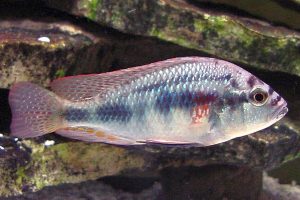Burton’s Mouthbrooder (Astatotilapia burtoni) has been found in Burundi, Rwanda, Tanzania, and Zambia, and is considered a Victorian cichlid from the middle of Lake Tanganyika, however, it has also been collected from Lake Kivu, which is north of Lake Tanganyika and west of Lake Victoria.
Burton’s Mouthbrooders, synonymous with Haplochromis burtoni, prefer living in the smaller streams, river mouths, shallower parts of lakes near the mouth of rivers, freshwater swamps, island deltas, and swamps near Lake Tanganyika; where several color varieties (including a blue and yellow morph) have been found.
Non territorial male, female, and juvenile Burton’s Mouthbrooders are a sandy gray green, silver/brown color and except for orange anal fin spots, lack any other distinctive markings. Juveniles may have a hint one or two horizontal bars and several faint narrow vertical lines on the body.
Dominant territorial male Burton’s Mouthbrooders are a bright gray to luminescent blue to yellow color, with lighter marbling, and a reddish orange splotch above the pectoral fins. They have several distinct black head markings consisting of 2 to 3 bars across the forehead, a horizontal bar that extends backward from the eye along the body, and a bar that extends from the mouth to the eye. They have blue dorsal and caudal fins with red spots, and an anal fin with an irregular row of 5 to 9 large orangs “egg” spots. Incubating females may also possess head markings.
Dominant male Burton’s Mouthbrooders from the Lake Tanganyika area have more of a blue “glow” to their body and a red splotch behind the gill covers. The
black mask over their head is also much more intense than the variants found in the Nile and Kivu lake basins. Specimens from the latter area also tend to have a more greenish glow over their body than the Tanganyikan variants.
Dominant male Burton’s Mouthbrooders are much more colorful than non-dominant males and females. Males also grow much larger than the females.
Male Burton’s Mouthbrooders are highly aggressive and become more so as they become adults. Males color up when another male is present in their territory and become as drab as the females when other males are absent.
Astatotilapia burtoni can be kept in groups of one male to at least three females in a tank with other fish that do not resemble Astatotilapia burtoni, to minimize aggressive behavior. A ratio of 3 males to 5 or 6 females in a single species tank will also minimize aggression, however keeping 3 males with several females will cause the demise of the sub-dominant male in short order. At a size of 3″ it is difficult to keep more than one male in a 55 gallon tank.
Although they can be kept with other aggressive fish like mbuna types, Burton’s Mouthbrooders are best kept in a single species aquarium of at least 55 gallon capacity, with a sandy or fine gravel substrate and plenty of rocks, heaped high, to provide hiding places for bullied females. Because they are mouthbrooders and enjoy digging in the substrate, only hardy plants, if any, should be provided. They do best in clean hard water that should be changed weekly, or at least every other week.
If you can keep the male from terrorizing everybody else in the tank, Burton’s Mouthbrooders are easy to breed. Spawning occurs like other Victorian cichlids; the females become gravid, produce eggs, and spawning occurs.
The male digs a breeding pit in the sand and vigorously defends it against intruders. He then entices a female into the breeding pit where the eggs are laid and fertilized. The female then holds the eggs in her mouth until hatching occurs, usually in about 18 to 22 days.
During breeding, the female will usually not eat and will keep hidden between the rocks. When the eggs hatch, the female will tend to the fry and hold them in her mouth until they become large enough to take care of themselves. The broods (from 12 to 20) and the fry are small, but the fry grow quickly. In about 5 weeks, they will grow to about one inch in length. The females are protective of their fry for a week or two after release. With the slightest scare, all the fry will scoot back into the mouth of the female for protection.
The fry can be fed baby brine shrimp or finely crushed omnivore flakes.
In their natural habitat, Burton’s Mouthbrooders are opportunistic predators that feed on aquatic insects, insect larvae, annelids, small fish, small rotifers, copepods, plant material, diatoms, seeds, and organic detritus. In an aquarium environment, they do well on a quality cichlid flake or pellet, augmented with Spirulina flakes and live, frozen, or freeze dried bloodworms, Daphnia
, earthworms, etc.
Astatotilapia burtoni is not a fish that tropical fish keeping enthusiasts will commonly see, however it is becoming more popular in fish keeping circles. They are available online and from specialty fish shops at a size of 1 1/2″ to 3″ at reasonable prices.
Minimum Tank Size: 55 gallons
Care Level: Difficult
Temperament: Aggressive
Aquarium Hardiness: Hardy
Water Conditions: 75-79° F, GH 7-11, pH 8.5-9.0
Max. Size: Males 5″, Females 4″
Color Form: Gray, Blue, Green
Diet: Omnivore
Compatibility: Community or Single species tank
Origin: West Africa
Family: Cichlidae
Lifespan: 10 years
Aquarist Experience Level: Beginner





